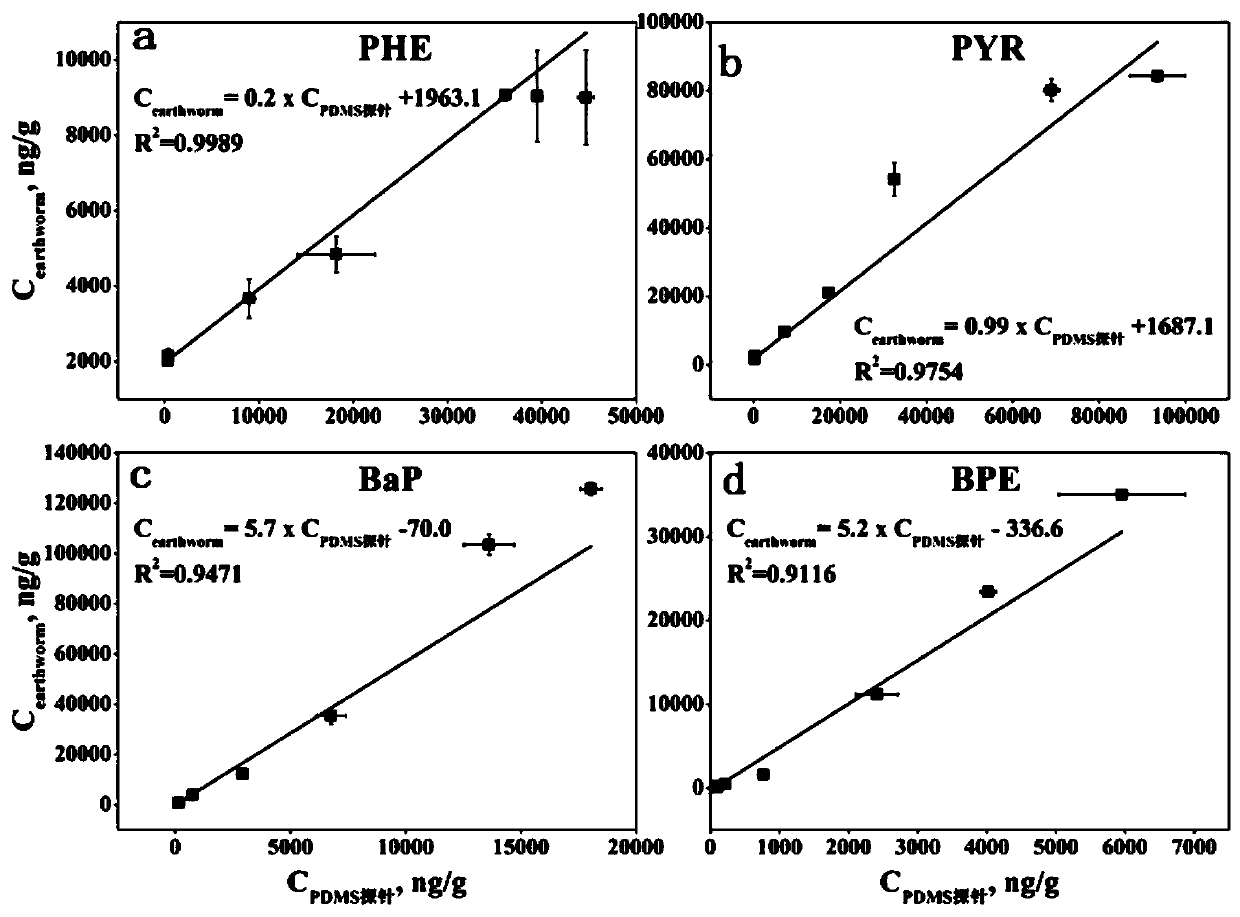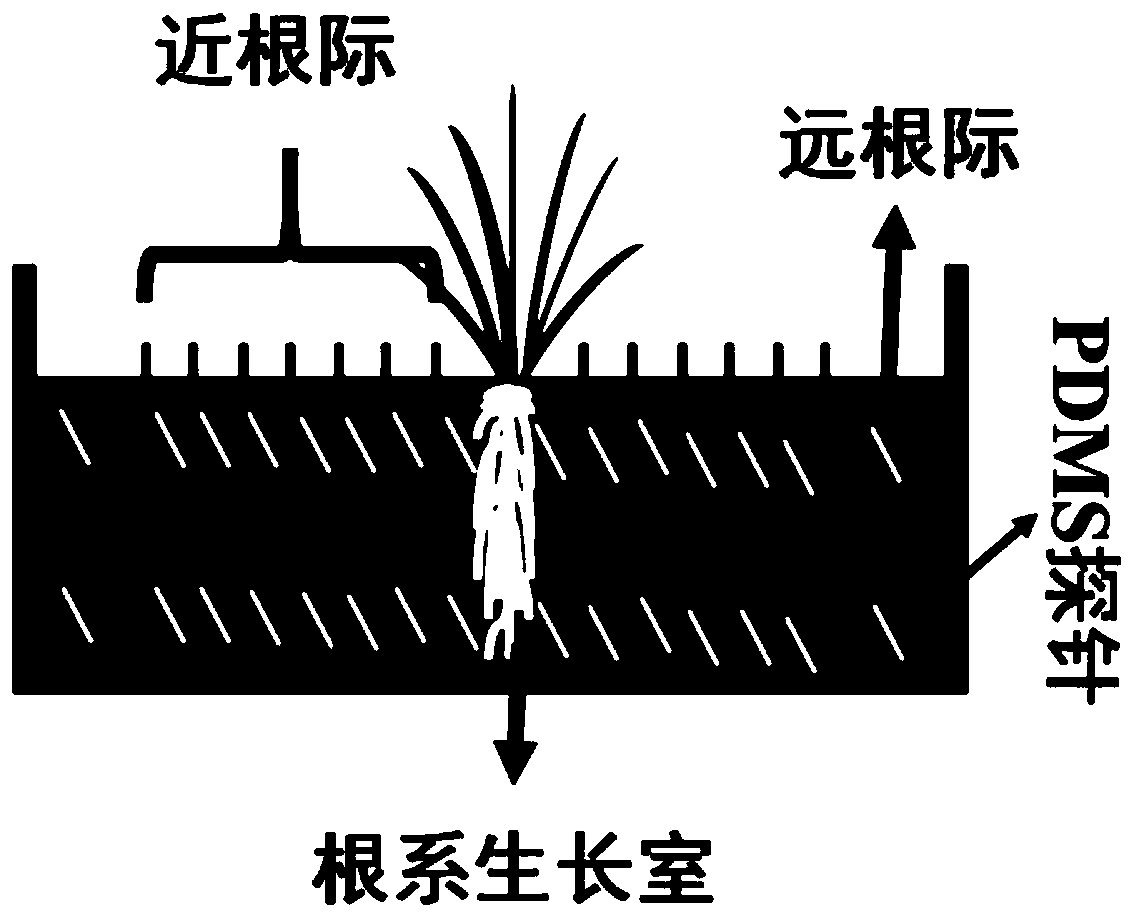Method for in-situ characterization of bioavailability of hydrophobic organic pollutants in soil microdomains
A technology of organic pollutants and bioavailability, applied in the field of environmental science and engineering, can solve the problems of bioavailability of organic substances that cannot be hydrophobic, and achieve stable and reliable results with low theoretical accuracy
- Summary
- Abstract
- Description
- Claims
- Application Information
AI Technical Summary
Problems solved by technology
Method used
Image
Examples
Embodiment 1
[0043] 1) Using the method of the present invention to adopt polydimethylsiloxane probes to in-situ cultivate and enrich polycyclic aromatic hydrocarbons in the soil, and the specific process of detecting the enriched polycyclic aromatic hydrocarbons is as follows:
[0044] a) Weigh 5g of polycyclic aromatic hydrocarbon-contaminated red soil in a 150mL transparent beaker, vibrate and lay flat;
[0045] b) Take three polydimethylsiloxane probes with a length of 4 cm and place them on the upper surface of the red soil at the bottom of the beaker. The polydimethylsiloxane probes are commercially available from Poly Micro Technologies, Inc., USA The probe, the mass ratio of the polydimethylsiloxane probe to the soil is less than one thousandth, the diameter of the polydimethylsiloxane probe is not greater than 110 μm, and the probe is in the soil The depth is greater than 1mm.
[0046] c) Weigh again 5g of PAH-contaminated red soil and place it above the polydimethylsiloxane prob...
Embodiment 2
[0059] The basic content of this embodiment is the same as embodiment 1, the difference is:
[0060] 1) Using the method of the present invention to use polydimethylsiloxane probes to in-situ cultivate and enrich polycyclic aromatic hydrocarbons in the soil, and the specific process of detecting the enriched polycyclic aromatic hydrocarbons is basically the same as that of Example 1, except that in:
[0061] a) Weigh 30g of polycyclic aromatic hydrocarbon-contaminated red soil in a 150mL transparent beaker, vibrate and lay flat;
[0062] b) Take 10 polydimethylsiloxane probes with a length of 4 cm and place them on the upper surface of the red soil at the bottom of the beaker. The polydimethylsiloxane probes are commercially available from Poly Micro Technologies in the United States. the probe;
[0063] c) Weigh again 30g of polycyclic aromatic hydrocarbon-contaminated red soil and place it above the polydimethylsiloxane probe, oscillate and shake well, completely cover the...
Embodiment 3
[0079] This example is the specific operation of the bioavailability characterization experiment of polycyclic aromatic hydrocarbons in the rhizosphere area:
[0080] 1) Weigh 2.5kg of PAHs-contaminated soil (dry weight), divide it into three treatment groups, namely blank (CK), add 1% corn straw charcoal, add 1% wheat straw charcoal, mix well, and load them layer by layer image 3 In the shown root box, the width of each layer along the horizontal direction is 1mm, and each layer of soil is covered with seven 4cm polydimethylsiloxane probes according to the method in Example 1, and the arrow position is the root growth chamber ,Such as image 3 Probes were embedded at the rhizosphere, proximal rhizosphere and distal rhizosphere regions shown; water was added to 60% of the maximum water holding capacity of the soil;
[0081] 2) Take germinated ryegrass seeds, place them on the surface soil of the root growth room, spread a layer of dry soil, and treat them in the dark for 2 d...
PUM
| Property | Measurement | Unit |
|---|---|---|
| diameter | aaaaa | aaaaa |
| degree of polymerization | aaaaa | aaaaa |
Abstract
Description
Claims
Application Information
 Login to View More
Login to View More - R&D
- Intellectual Property
- Life Sciences
- Materials
- Tech Scout
- Unparalleled Data Quality
- Higher Quality Content
- 60% Fewer Hallucinations
Browse by: Latest US Patents, China's latest patents, Technical Efficacy Thesaurus, Application Domain, Technology Topic, Popular Technical Reports.
© 2025 PatSnap. All rights reserved.Legal|Privacy policy|Modern Slavery Act Transparency Statement|Sitemap|About US| Contact US: help@patsnap.com



